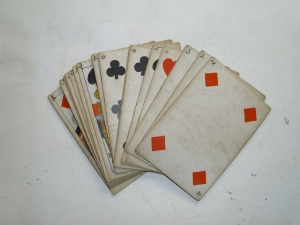Do you like Charity Shops? I do as you never know what you might find in them, and in my case where the discovery might take you.

A little while ago I was in a local shop when I spotted a pack of playing cards in a glass case. I could see that the numbers had been written on, which told me that they were of some age as I knew numbers had been added to cards in the nineteenth century. Incidentally this had led to the term ‘Jack’ becoming socially acceptable, before this the lowest value court card had been known as the Knave in polite society, Jack was a much more lower class term (like using serviette instead of napkin). Thus in Great Expectations;
“He calls the knaves Jacks, this boy!” said Estella with disdain.
But when there was a need to put a letter on a card to identify it, K couldn’t be used for both King and Knave, so Jack had to become the official name of the card.
I naturally had the cards taken from the case to look at the court cards, since at the beginning of the century the figures had legs, then about the middle of the century they became double headed. These cards were double headed, so I guessed they must date from the middle of the century, I therefore paid a few pounds so I could investigate them further.


A little searching soon revealed that the cards dated from between 1862 and 1865, and then I was surprised to discover that the pattern on the back had been designed by Owen Jones.

Jones was one of the finest, if least known, Victorian designers. He was an early pioneer of colour theory who had designed the colour scheme for the Crystal Palace, in order to make the interior look bigger than it was. He had also designed the decoration of one of the most delightful Victorian church in Dorset, Sutton Waldron.


The walls are painted dark red and light blue. Whilst the floors are covered with wonderful mosaic patterns. Looking at them, it is easy to see that Owen Jones was one of the first people to appreciate the decoration of the Alhambra in Spain. In fact his work almost killed him, he was making drawings of the designs in the building when cholera broke out in the area, he refused to leave until the work was done, other people at the Alhambra at the same time died. Returning, he published a magnificent book on the Alhambra, which led to its international recognition, and made the Spanish take more care of it (local people were chipping bits off the mosaics to sell to tourists.


And that is where you can go with something picked up at a charity shop, I will doubtless discuss these shops again, how they vary from town to town, and some of the more curious objects I have picked up from them. After all if you saw a piece of pottery labelled, ‘A puzzle jug with a lithophane’ you would naturally want to see what the lithophane showed – but that is another story.

Reblogged this on TanGental and commented:
The benefits of charity and thrift shops, at least if you know what you’re looking for.
LikeLiked by 1 person
Wow, so much I didn’t know about cards. Great find, and thanks for the lesson. 🙂
LikeLike
My pleasure
LikeLiked by 1 person
Utterly fascinating! The only thing I knew before was that it wasn’t done to call Knaves Jacks. Great stuff.
LikeLike
This is so interesting you are definitely an encyclopaedia on legs. I found all the information on the cards extremely interesting . What a find the card design by Owen Jones, what a talented man he was. I look forward to reading more of your second hand / charity shops. We actually have at least six charity shops in our town!!
LikeLike
Great information about cards. Thank you!
LikeLike
Not only are the cards beautiful on their own, discovering the connection with Sutton Waldron and the Alhambra makes them very special. What a great find and a great story!
LikeLike
What a find! The design on the back is beautiful.
LikeLiked by 1 person
Pingback: A Charity Case – the work of an ‘Accomplished Lady” ? | The Curious Archaeologist